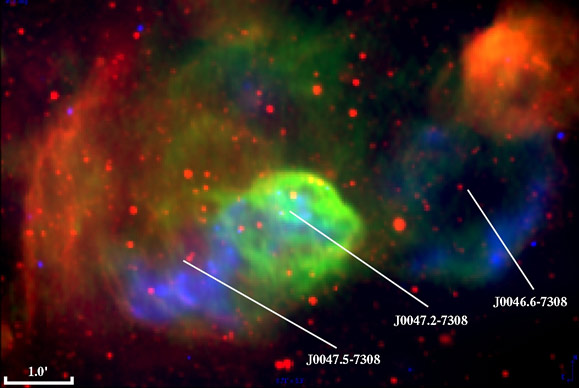Stars Cooperate to Blow Super Space Bubble

Massive stars and their dead brethren areteaming up to build a colossal space bubble outside our Milky Way galaxy.
Expanding envelopesof gas and dust shed by massive stars and supernovas are in the act ofmerging in a peculiar region of the SmallMagellanic Cloud, one of two dwarf galaxiesnear the Milky Way.
"We arewitnessing the birth of a superbubble," said Rosa Williams, an astronomer at theUniversity of Illinois at Urbana-Champaign, in a statement.
Thesuperbubble spied by Williams and her colleagues is coming together in a regionof the Small Magellanic Cloud known as LHa115-N19 (N19), an area rich withionized hydrogen gas and populated by massive stars blowing out their own dustand gas in stellar winds [image].Supernova remnants, vast gas shells belched out during a star's explosivedemise, also appear in the region, researchers said [image].
"In N19, wehave not one star, but a number of massive stars blowing bubbles and we haveseveral supernova remnants," Williams said, adding that the shells and cavitiescarved the objects may overlap. "Eventually, these bubbles could merge into oneenormous cavity, called a superbubble."
Williamsled the superbubble study and presented her team's findings this week at a Seattlemeeting of the American Astronomical Society. The astronomers relied on X-ray datafrom the Chandra X-ray Observatory, as well as optical and spectroscopicmeasurements to identify their superbubble-in-the-making.
"We caughtthis particular region of N19 at a neat moment in time," Williams said. "Thestars are just dispersed enough that their stellar winds and supernova blastsare working together, but have not yet carved out a full cavity."
Breaking space news, the latest updates on rocket launches, skywatching events and more!
The cosmicformation not only gives astronomers a deeper glimpse into the lifecycles ofmassive stars, but may also prove fruitful for planetary formation research.During their lifecycles, massive stars generate - and ultimately distribute viasupernova - the heavy elements that are crucial for the formation of planets, researchers said.
"Our own solar system may have formedwithin the confines of a superbubble," Williams said.
- Speedy Discovery Fuels New Milky Way Mystery
- IMAGES: Hubble Space Telescope's New Views of the Universe
- VIDEO: Supernovas - Destroyers and Creators
- VIDEO: Beacons in the Night
- All About Supernovas

Tariq is the award-winning Editor-in-Chief of Space.com and joined the team in 2001. He covers human spaceflight, as well as skywatching and entertainment. He became Space.com's Editor-in-Chief in 2019. Before joining Space.com, Tariq was a staff reporter for The Los Angeles Times covering education and city beats in La Habra, Fullerton and Huntington Beach. He's a recipient of the 2022 Harry Kolcum Award for excellence in space reporting and the 2025 Space Pioneer Award from the National Space Society. He is an Eagle Scout and Space Camp alum with journalism degrees from the USC and NYU. You can find Tariq at Space.com and as the co-host to the This Week In Space podcast on the TWiT network. To see his latest project, you can follow Tariq on Twitter @tariqjmalik.
